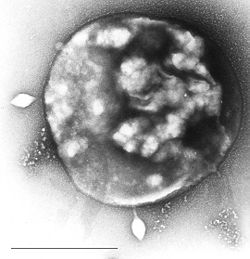| Sulfolobus tengchongensis spindle-shaped virus | |
|---|---|
 | |
| Electron micrograph of Sulfolobus infected with Sulfolobus virus STSV1. Bar = 1 μm. | |
| Virus classification | |
| Group: | Group I (dsDNA) |
| Order: | Unassigned |
| Family: | |
| Genus: | not assigned |
| Species: | Sulfolobus tengchongensis spindle-shaped virus 1 |
Sulfolobus tengchongensis spindle-shaped virus 1 (STSV1) is a DNA virus of the family Bicaudaviridae . It infects the hyperthermophilic archaeon SuSulfolobus tengchongensis spindle-shaped viruslfolobus tengchongensis which can be found in the volcanic area of Tengchong, Baoshan City, in western Yunnan province, People's Republic of China. [1] [2]
In 2014, Sulfolobus tengchongensis spindle-shaped virus 2 (STSV2), a relative of STSV1, also infecting S. tengchongensis, has been reported. [3] Besides S. tengchongensis, STSV2 infects Sulfolobus islandicus REY15A. It has been demonstrated that STSV2 induces unprecedented gigantism of S. islandicus cells by blocking the expression of the cell division genes and arresting the cell cycle in the S phase. [4] The diameter of infected cells increases up to 20 times, resulting in 8,000-fold increase in volume compared to noninfected cells. [4]
Sulfolobus tengchongensis spindle-shaped virus (STSV) is a highly specialized archaeal virus that infects the thermoacidophilic archaeon Sulfolobus tengchongensis , which thrives in extreme geothermal environments such as hot springs with high temperature and low pH. Belonging to the family Fuselloviridae, STSV exhibits a distinctive spindle-shaped, or fusiform, morphology with pointed ends, which is markedly different from the icosahedral structures commonly seen in bacteriophages and eukaryotic viruses.
Its genome consists of circular double-stranded DNA that encodes a variety of proteins essential for viral replication, capsid assembly, and interactions with its archaeal host. Unlike many lytic viruses, STSV often establishes chronic infections, allowing continuous replication without immediate lysis of the host cell. This adaptation is thought to be advantageous in extreme environments, where host cells are sparse and environmental conditions are harsh.
The virus assembles within the cytoplasm and can be released via a budding-like mechanism, sometimes enveloped in host-derived lipids, which facilitates persistent infection. Beyond its ecological niche, STSV provides critical insights into viral evolution in archaea, revealing unique gene modules and replication strategies that differ from bacterial and eukaryotic viruses. Its spindle-shaped morphology, combined with the presence of unique structural proteins and lipid interactions, makes it a valuable model for studying virus-host coevolution, morphogenesis, and survival strategies in extreme environments. [5]